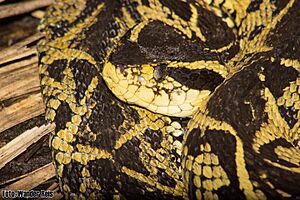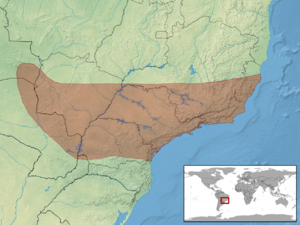Bothrops jararacussu facts for kids
Quick facts for kids Bothrops jararacussu |
|
|---|---|
 |
|
| Conservation status | |
| Scientific classification | |
| Genus: |
Bothrops
|
| Species: |
jararacussu
|
 |
|
| Synonyms | |
|
|
The Bothrops jararacussu, often called the jararacussu in English, is a very venomous snake. It belongs to a group called pit vipers. This snake is found only in South America. It is known as one of the largest and most powerful snakes in its home region. It can grow to be about 2.2 metres (7.2 ft) long.
Contents
What Does the Jararacussu Look Like?
The jararacussu is a large snake. It can reach up to 2.2 meters (about 7 feet) in length. It has a strong body and a broad head. Its colors can vary a lot. Some are brown or yellow, while others are almost black.
Unique Patterns and Features
The snake's body has a cool pattern of dark and light scales. These patterns form a series of dark arches. These spots often look like the letter 'x' along its back. The jararacussu has medium-sized eyes. Its pupils are shaped like vertical slits. Its scales on its back are also strongly ridged.
How Does the Jararacussu Behave?
This snake is known for being quite active. It has large fangs, which can be up to 2.5 cm (about 1 inch) long. These fangs help it inject a lot of venom.
What Does It Eat?
The jararacussu mainly eats amphibians, like frogs, and small rodents. It is a predator that hunts for its food.
Reproduction and Life Cycle
These snakes are ovoviviparous. This means the mother carries the eggs inside her body. The young hatch inside her and are born live. A female jararacussu usually gives birth to 16 to 20 young snakes. This often happens during the rainy season.
Daily Habits
The jararacussu is active both during the day and at night. In the morning, it likes to warm up in the sun. When night comes, it goes out to hunt for food.
Where Does the Jararacussu Live?
This snake lives in South America. You can find it in several countries.
Geographic Range
Its home includes coastal Brazil. It lives from the state of Bahia down to Santa Catarina. It is also found in Paraguay, southeastern Bolivia, and northeastern Argentina. In Argentina, it lives in the Misiones Province.
Habitats
The jararacussu prefers certain types of forests. It lives in the Atlantic Forest and semi-deciduous forests. These are forests where some trees lose their leaves. It also lives in evergreen forests and pine forests in Paraná, Brazil. You might also find it in low, swampy areas and along river banks.
What Are Its Other Names?
In Brazil, the Bothrops jararacussu has many different common names. Some of these include jararacuçu, jararacuçu-verdadeiro, patrona, surucucu, surucucu-dourada, surucucu-tapete, urutu-dourado, and urutu-estrela.
Names in Other Regions
In other parts of South America, people call it by names like Yarara-cussu, Yarara dorada, Yarara guasu, Yarara guazu, Painted Yope, and Yoperojobobo.
Understanding Jararacussu Venom
Like all snakes in the Bothrops family, the jararacussu has very strong venom. This venom is powerful enough to cause serious harm.
Effects of the Venom
The venom contains different types of toxins. These include cytotoxins (which harm cells), hemotoxins (which affect blood), and myotoxins (which damage muscles). Studies have looked at people bitten by these snakes. Bites from larger snakes (over 50 cm) often caused severe local and body-wide effects. These included tissue damage, shock, bleeding, and kidney problems.
Venom Impact on the Body
Smaller snakes were more likely to cause blood not to clot properly. Some people experienced bleeding problems. Others had tissue damage, which sometimes led to needing surgery. In some cases, people went into shock or had kidney failure. Sadly, some very young or older patients did not survive, even with medical care. Autopsies showed severe damage to organs like the kidneys and brain.
Venom Potency and Research
Research has shown how potent the venom is. Scientists measure venom strength using something called LD50. For the jararacussu, a very small amount of venom can be dangerous. The snake can produce a large amount of venom in one bite. Scientists have also found specific toxins in the venom, like BthTX-I and BthTX-II. These toxins can cause swelling, muscle damage, and harm to cells.


